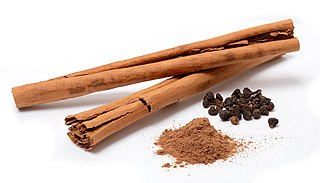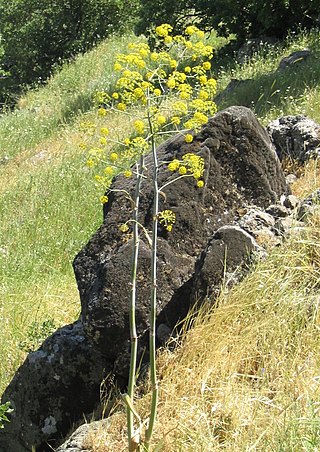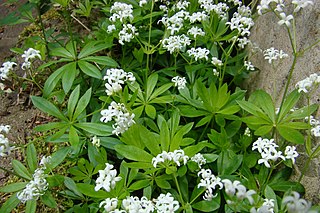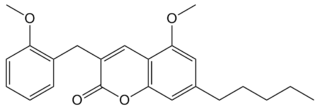
Cinnamon is a spice obtained from the inner bark of several tree species from the genus Cinnamomum. Cinnamon is used mainly as an aromatic condiment and flavouring additive in a wide variety of cuisines, sweet and savoury dishes, breakfast cereals, snack foods, bagels, teas, hot chocolate and traditional foods. The aroma and flavour of cinnamon derive from its essential oil and principal component, cinnamaldehyde, as well as numerous other constituents including eugenol.

Asafoetida is the dried latex exuded from the rhizome or tap root of several species of Ferula, perennial herbs of the carrot family. It is produced in Iran, Afghanistan, Central Asia, northern India, and Northwest China (Xinjiang). Different regions have different botanical sources.

Silphium, σίλφιον (sílphion) in ancient Greek, is an unidentified plant that was used in classical antiquity as a seasoning, perfume, aphrodisiac, and medicine.

Ferula is a genus of about 220 species of flowering plants in the family Apiaceae, native to the Mediterranean region east to central Asia, mostly growing in arid climates. They are herbaceous perennial plants growing to 1–4 m tall, with stout, hollow, somewhat succulent stems. The leaves are tripinnate or even more finely divided, with a stout basal sheath clasping the stem. The basal sheaths of Ferula oopoda are up to six inches (15 cm) long and form a cup holding about a cup of rainwater, possibly to draw pollinators in an arid land. The flowers are usually yellow, rarely white, produced in large umbels. Many plants of this genus, especially F. communis, are referred to as "giant fennel," although they are not fennel in the strict sense.

Coumarin or 2H-chromen-2-one is an aromatic organic chemical compound with formula C9H6O2. Its molecule can be described as a benzene molecule with two adjacent hydrogen atoms replaced by an unsaturated lactone ring −(CH)=(CH)−(C=O)−O−, forming a second six-membered heterocycle that shares two carbons with the benzene ring. It belongs to the benzopyrone chemical class and considered as a lactone.

Galium odoratum, the sweet woodruff or sweetscented bedstraw, is a flowering perennial plant in the family Rubiaceae, native to much of Europe from Spain and Ireland to Russia, as well as Western Siberia, Turkey, Iran, the Caucasus, China and Japan. It is also sparingly naturalised in scattered locations in the United States and Canada. It is widely cultivated for its flowers and its sweet-smelling foliage.

Ruta graveolens, commonly known as rue, common rue or herb-of-grace, is a species of the genus Ruta grown as an ornamental plant and herb. It is native to the Balkan Peninsula. It is grown throughout the world in gardens, especially for its bluish leaves, and sometimes for its tolerance of hot and dry soil conditions. It is also cultivated as a culinary herb, and to a lesser extent as an insect repellent and incense.

Dipteryx odorata is a species of flowering tree in the pea family, Fabaceae. The tree is native to Northern South America and is semi-deciduous. Its seeds are known as tonka beans. They are black and wrinkled and have a smooth, brown interior. They have a strong fragrance similar to sweet woodruff due to their high content of coumarin.

Umbelliferone, also known as 7-hydroxycoumarin, hydrangine, skimmetine, and beta-umbelliferone, is a natural product of the coumarin family.

The heart symbol is an ideograph used to express the idea of the "heart" in its metaphorical or symbolic sense. Represented by an anatomically inaccurate shape, the heart symbol is often used to represent the center of emotion, including affection and love, especially romantic love. It is sometimes accompanied or superseded by the "wounded heart" symbol, depicted as a heart symbol pierced with an arrow or as a heart symbol "broken" into two or more pieces, indicating lovesickness.

Galbanum is an aromatic gum resin and a product of certain umbelliferous Persian plant species in the genus Ferula, chiefly Ferula gummosa and Ferula rubricaulis. Galbanum-yielding plants grow plentifully on the slopes of the mountain ranges of northern Iran. It occurs usually in hard or soft, irregular, more or less translucent and shining lumps, or occasionally in separate tears, of a light-brown, yellowish or greenish-yellow colour. Galbanum has a disagreeable, bitter taste, a peculiar, a somewhat musky odour, and an intense green scent. With a specific gravity of 1.212, it contains about 8% terpenes; about 65% of a resin which contains sulfur; about 20% gum; and a very small quantity of the colorless crystalline substance umbelliferone. It also contains α-pinene, β-pinene, limonene, cadinene, 3-carene, and ocimene.

Saigon cinnamon is an evergreen tree indigenous to mainland Southeast Asia. Saigon cinnamon is more closely related to cassia than to Ceylon cinnamon, though in the same genus as both. Saigon cinnamon has 1-5% essential oil content and 25% cinnamaldehyde in essential oil. Consequently, among the species, Saigon cinnamon commands a relatively high price.

Selinum carvifolia is a flowering plant of the genus Selinum in the family Apiaceae. The specific name carvifolia signifies 'having leaves resembling those of Caraway'. It is a plant of fens and damp meadows, growing in most of Europe, with the exception of much of the Mediterranean region, eastwards to Central Asia. Its common name in English is Cambridge milk parsley, because it is confined, in the UK, to the county of Cambridgeshire and closely resembles milk parsley, an umbellifer of another genus, but found in similar habitats. The two plants are not only similar in appearance, but also grow in similar moist habitats, although they may be told apart in the following manner: P. palustre has hollow, often purplish stems, pinnatifid leaf lobes and deflexed bracteoles; while S. carvifolia has solid, greenish stems, entire or sometimes lobed leaf-lobes and erecto-patent bracteoles. Also, when the two plants are in fruit, another difference becomes apparent: the three dorsal ridges on the fruit of S. carvifolia are winged, while those on the fruit of P. palustre are not. Yet a further difference lies in the respective leaflets of the plants : those of Peucedanum palustre are blunt and pale at the tip, while those of Selinum carvifolia are sharply pointed and of a darker green. S. carvifolia used also to occur in the English counties of Nottinghamshire and Lincolnshire but is now extinct in both. Growing in only three small Cambridgeshire fens, it is one of England's rarest umbellifers. It is naturalized in the United States, where it is known by the common name little-leaf angelica.

Ferula tingitana, the giant Tangier fennel, is a species of the Apiaceae genus Ferula. Despite the name, the plant is not a type of fennel proper, which belongs to another genus (Foeniculum).

Ferula communis, the giant fennel, is a species of flowering plant in the carrot family Apiaceae. It is related to the common fennel, which belongs to the same family.

The papal ferula is the pastoral staff used in the Catholic Church by the pope. It is a rod with a knob on top surmounted by a cross. It differs from a crosier, the staff carried by other Latin Church bishops, which is curved or bent at the top in the style of a shepherd's crook.
PSB-SB-487 is a coumarin derivative which is an antagonist at the former orphan receptor GPR55. Unlike older GPR55 antagonists such as O-1918, PSB-SB-487 has good selectivity over the related receptor GPR18, with an IC50 of 113nM at GPR55 vs 12500nM at GPR18. However it has poorer selectivity over other related receptors, acting as a weak antagonist at CB1 with a Ki of 1170nM, and a partial agonist at CB2 with a Ki of 292nM.

PSB-SB-1202 is a coumarin derivative which is an agonist at the cannabinoid receptors CB1 and CB2, with a CB1 Ki of 32nM and a CB2 Ki of 49nM. It is also a weak antagonist at the related receptor GPR55, with an IC50 of 6350nM, but has no significant affinity for GPR18.

4-Hydroxycoumarin is a coumarin derivative with a hydroxy group at the 4-position.

Ferula narthex is a species of plant native to Afghanistan, Tajikistan, northern Pakistan and Kashmir. Although it is often listed as the source of asafoetida, one report stated that its essential oil lacked sulfur-containing compounds which are characteristic of asafoetida.



















